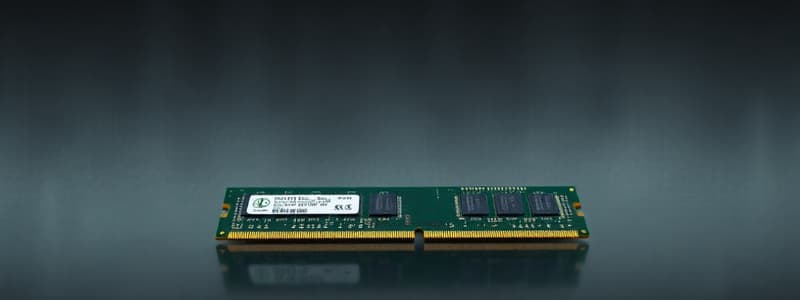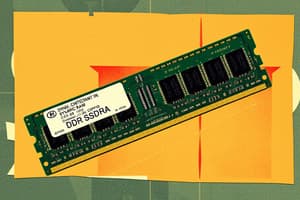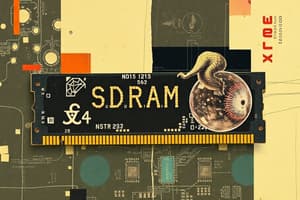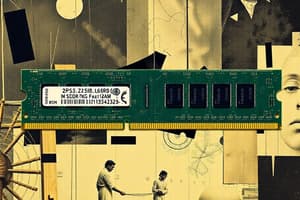Podcast
Questions and Answers
What does DDR stand for in RAM terminology?
What does DDR stand for in RAM terminology?
- Dynamic Data Rate
- Dual Data Rate
- Double Digital Rate
- Double Data Rate (correct)
How does DDR RAM increase processing speed compared to original DRAM?
How does DDR RAM increase processing speed compared to original DRAM?
- By using a lower bus frequency
- By processing commands in parallel
- By handling larger data sets in each cycle
- By processing data on both the rising and falling edges of clock cycles (correct)
What does the MT/s rating stand for in DDR RAM specifications?
What does the MT/s rating stand for in DDR RAM specifications?
- Mega Transfers per second (correct)
- Mega Threads per second
- Mega Techniques per second
- Mega Traces per second
How is the PC rating of RAM calculated?
How is the PC rating of RAM calculated?
Which of the following statements is true about the original DRAM?
Which of the following statements is true about the original DRAM?
Which bus speed corresponds to a DDR-266 specification?
Which bus speed corresponds to a DDR-266 specification?
What is the primary function of RAM in a computer system?
What is the primary function of RAM in a computer system?
What does the term 'double pumping' refer to in DDR RAM?
What does the term 'double pumping' refer to in DDR RAM?
What operating voltage does DDR4 operate at?
What operating voltage does DDR4 operate at?
Which DDR type has the highest data rate between 1066 and 1600 MT/s?
Which DDR type has the highest data rate between 1066 and 1600 MT/s?
How many pins does DDR2 memory have?
How many pins does DDR2 memory have?
Which DDR version introduced the feature of having power management on the RAM stick itself?
Which DDR version introduced the feature of having power management on the RAM stick itself?
What is the maximum chip density for DDR3 memory per stick?
What is the maximum chip density for DDR3 memory per stick?
What type of memory module is typically installed on a desktop system?
What type of memory module is typically installed on a desktop system?
Which configuration allows each memory stick to be assigned to a single memory controller?
Which configuration allows each memory stick to be assigned to a single memory controller?
What is the primary benefit of a multi-channel memory configuration?
What is the primary benefit of a multi-channel memory configuration?
Which of the following statements regarding DDR2 is accurate?
Which of the following statements regarding DDR2 is accurate?
How does DDR5 improve latency compared to earlier DDR types?
How does DDR5 improve latency compared to earlier DDR types?
What is the typical PC rating for DDR3 memory?
What is the typical PC rating for DDR3 memory?
Which DDR type has an operating voltage of 1.8 volts?
Which DDR type has an operating voltage of 1.8 volts?
What is one of the key physical differences between DDR and DDR2 RAM?
What is one of the key physical differences between DDR and DDR2 RAM?
Which option describes the characteristic of SO-DIMMs?
Which option describes the characteristic of SO-DIMMs?
Flashcards
DRAM
DRAM
Dynamic Random Access Memory, the most common type of computer memory.
DDR RAM
DDR RAM
Double Data Rate RAM, a type of RAM that processes data on both the rising and falling edges of a clock cycle, effectively doubling the speed.
Clock Cycle
Clock Cycle
A single unit of time in a computer's clock speed.
Bus Frequency
Bus Frequency
Signup and view all the flashcards
DDR Rating
DDR Rating
Signup and view all the flashcards
PC Rating
PC Rating
Signup and view all the flashcards
Double Pumping
Double Pumping
Signup and view all the flashcards
Word (RAM)
Word (RAM)
Signup and view all the flashcards
DDR RAM Types
DDR RAM Types
Signup and view all the flashcards
DDR1 RAM
DDR1 RAM
Signup and view all the flashcards
DDR2 RAM
DDR2 RAM
Signup and view all the flashcards
DDR3 RAM
DDR3 RAM
Signup and view all the flashcards
DDR4 RAM
DDR4 RAM
Signup and view all the flashcards
DDR5 RAM
DDR5 RAM
Signup and view all the flashcards
Bus Frequency
Bus Frequency
Signup and view all the flashcards
DIMM
DIMM
Signup and view all the flashcards
SO-DIMM
SO-DIMM
Signup and view all the flashcards
Multi-Channel Memory
Multi-Channel Memory
Signup and view all the flashcards
PC Rating
PC Rating
Signup and view all the flashcards
UniDIMM
UniDIMM
Signup and view all the flashcards
Memory Controller
Memory Controller
Signup and view all the flashcards
Study Notes
DDR RAM Types
- Dynamic Random Access Memory (DRAM) is the most common type of computer memory.
- DRAM processes one command and one 64-bit data set (word) per clock cycle.
- Original DRAM processed one command/word per rising edge of the clock cycle.
- DDR RAM (Double Data Rate RAM) doubles the data rate by processing one set of data on both rising and falling edges of each clock cycle (double pumping).
DDR RAM Ratings
- Speed is often represented in MHz (bus speed).
- MT/s (mega transfers per second) represents the effective transfer rate (DDR rating).
- DDR rating is calculated by doubling the bus clock speed.
- PC rating (bandwidth) is the amount of data transferred per second.
- PC rating is calculated by multiplying the DDR rating by 8 (8 bytes = 64 bits).
- PC rating value is typically rounded down/up for marketing purposes.
DDR RAM Types
- DDR1: Operated at 133-200 MHz (266-400 MT/s), 2.5V, 2100-3200 MB/s bandwidth.
- DDR2: Doubled DDR1 specs: 266-400 MHz (533-800 MT/s), 1.8V, 4200-6400 MB/s bandwidth. Added buffer for increased speed.
- DDR3: Doubled DDR2 specs: 533-800 MHz (1066-1600 MT/s), 1.5V, 8500-14900 MB/s bandwidth.
- DDR4: Doubled DDR3 data rate and power saving features: 1.2V, up to 64GB sticks, lower power consumption and cooler operation.
- DDR5: Doubled DDR4 data rate, lower voltage (1.1V), RAM-integrated power management with 32-bit split channels or 4 x 32-bit channels, and increased chip densities for up to 64GB sticks.
Physical Characteristics
- DDR has 184 pins, DDR2 has 240 pins.
- The notch positions differ between DDR types, providing easy distinction.
- DDR3 and DDR4 have 240 and 288 pins respectively.
- DDR5 has 288 pins.
Memory Form Factors
- DIMM (Dual In-Line Memory Module): Used in Desktop computers.
- SO-DIMM (Small Outline DIMM): Used in Laptops. Smaller size, same capacity.
- UniDIMM: Allows DDR3 and DDR4 in same slot, requires support from memory controller.
Multi-Channel Configurations
- Multi-channel configurations increase bandwidth by splitting workload over multiple memory controllers.
- A typical system has one memory controller.
- Multi-channel adds more memory controllers.
- Quad-channel setup allows up to eight RAM sticks.
- The use of dual, triple, or quad channels generally improves memory bandwidth by 5-15% (varies).
- Multi-channel configuration depends on the motherboard, not the RAM itself.
- Dual, triple, and quad channels are supported by DDR3, DDR4, and DDR5. DDR1 and DDR2 only support dual channel.
Studying That Suits You
Use AI to generate personalized quizzes and flashcards to suit your learning preferences.




